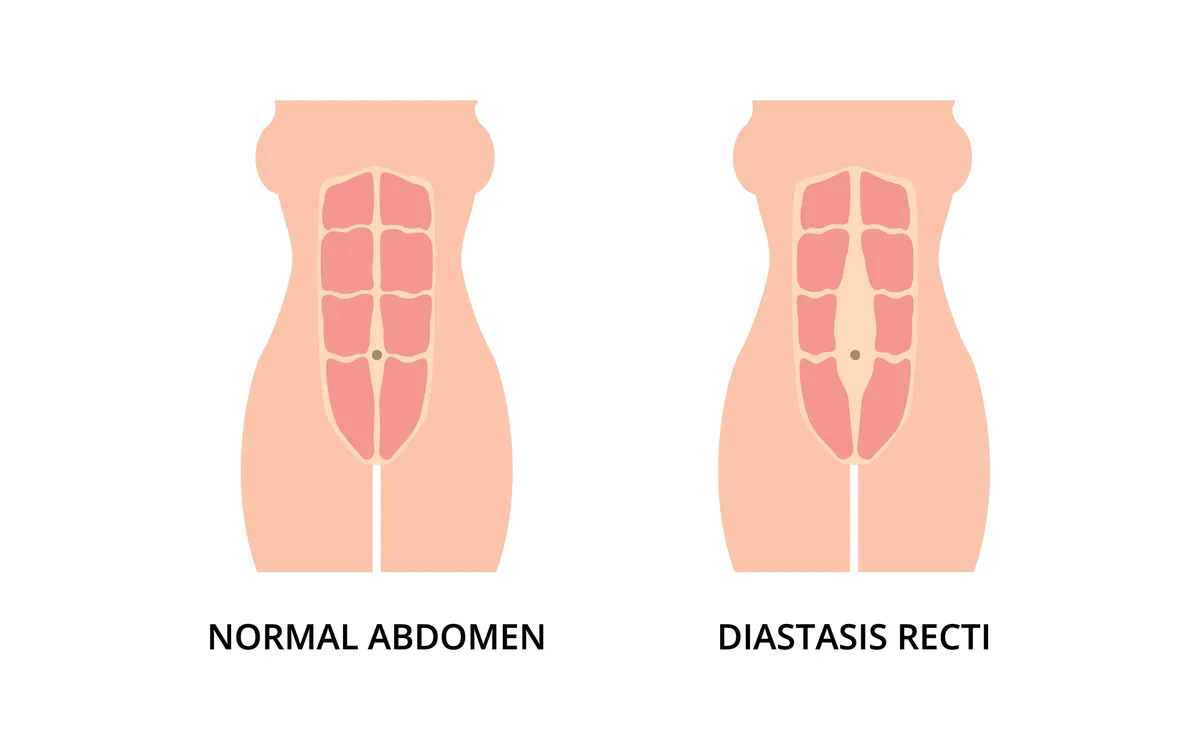As a postnatal instructor and PT to mums for over six years now, I answer questions about tummy gaps on a weekly, if not daily, basis. And to say I feel passionate about the fact that mothers are not well-informed or educated enough on this matter – a matter that affects such a large group – is an understatement. So let's get started on this important, but little understood, subject…
What is the tummy gap?
Diastasis recti is the separation of abdominal or recti sheaths in our midline and results in the stretching of the connective tissues during pregnancy. In simple terms, it’s the separating of our six-pack muscles into two halves.

How do you get a tummy gap?
During pregnancy, your baby is growing and needs extra space. Hormonal changes allow connective tissues (i.e the linea alba) to stretch and become lax allowing your body to accommodate your little peanut to grow and thrive in your belly.
This separation can sometimes show as a dark line in the middle of your bump (the linea negra). While this stretching is necessary during pregnancy it can cause problems after birth.
Being able to contain pressure tightly in your abdomen when lifting is necessary to support your spine and avoid injury. The weakened, stretched connective tissues do not allow this to happen.
How do I check for a tummy gap?
- With feet placed directly underneath the knees at hip-width apart, place two fingers directly above the belly button with your head on the ground.
- Relax all muscles, take a deep breath, and slowly lift your head, neck and shoulders off the ground into a low-level curl up (not full crunch).
- In this position, move the fingers up and down the midline (below and above the belly button length ways), as well seeing if you can fit more than two fingers width-wise.
- If the gap is more than 2cm or two fingers, seek a check and help from a postnatal specialist, GP or women’s physio. If you’re still unsure, always get a second and third check. I had one client who I identified as having a three-finger gap. She then went to a few different doctors before the diastasis was diagnosed and she was finally offered physio.
How soon does the tummy gap return to normal?
For some new mums, separation will come back together and repair relatively quickly, usually within 10-12 weeks. For others it can take a bit more time, this can be down to genetics, lack of core strength prior to pregnancy, larger babies, consecutive pregnancies, or because of over exertion of the ab muscles during pregnancy.
What happens if the tummy gap doesn’t close?
If diastasis recti continues past the 10-12 weeks, the ab muscles are unable to function efficiently and as a consequence cannot properly support the lumbar spine or the abdominal viscera.
If not addressed, this can lead to back aches, weak core and pelvic floor muscles, pelvic pain, and possible incontinence later on.
This is not to sound alarmist if you do have a gap. The path to recovery simply means going back to ‘basics’ to build up your internal core strength.
I usually recommend to clients that they work on abdominal contractions and breathing exercises (exhaling as you draw the navel to the spine) regularly throughout the day (5-10 sets of 10 contractions).
What exercises can you do to reduce a tummy gap?
The abdominal muscles require a level of engagement to allow for, and speed up, the core restore process.
Activating your ab muscles when you are about to perform moderate lifts, pushes or pulls and exhaling throughout will help to build some core strength and help to contain the pressure those movements create.
Here are some other exercises (using exhalations on the exertion and inhalations on the release):
- The bird dog pose (extending opposite arm & leg) and hold for 10secs before swapping.
- Pelvic tilts and lifts while lying on your back with knees bent and feet directly placed underneath hip-width apart.
- Lying hip rotations, in the previous pelvic lift position, drop knee laterally, extend the leg and draw the foot back to meet the other before swapping sides.
- Gentle ab curls, from the same position as 2 and 3, lifting and reaching to the opposite bent knee before lowering to return bringing the hand to the temple.
What exercises should you avoid to correct a tummy gap?
Exercises that create a lot of pressure in your abdomen will not help to fix this issue, such as crunches or twists, which recruit the external ab muscles and may cause a ‘doming’ or ‘bulging’ effect.
This is why postnatal specialists do not recommend ab specific exercises, lifting heavy weights and performing less controlled movement exercises until the core strength is restored.
It’s important during the immediate postnatal period that the muscles are not strained or exercised in such a way that will stress this weakened area.
Post-natal physical care
I read this quote on Instagram recently: “My GP wasn’t interested in my physical or mental health at my six-week check. It was all about the baby. I feel like I was treated like a princess during my pregnancy, but I became irrelevant after the baby was outside of me.”
I felt this quote sadly nailed it on the head. Having two children myself and visiting the GP during the 6-8 week check-up, I felt like a second-class citizen.
My physical recovery glossed over, my mental state addressed via a perfunctory box to check, and contraceptive options thrown at me (as if that was something that needed addressing at that point anyway!).
Tummy gap? Not even mentioned. Luckily, this is something I knew to check myself. This is not the case for all, sadly, and many remain unaware. Yet this is widespread problem.
I know this from the sheer volume of my own clients with a greater-than-two-fingers or 2cm gap who are in need of additional help to ‘close the gap’. I make it my responsibility to check all new clients at their first class or session.
After identifying a gap, prescribing exercises, and checking them again 4-6 weeks later, I will always refer them to a physio if it has not closed.
Information is power and spreading the word is the most effective way of empowering others. The fact that there is a growing amount of information on diastasis recti at our disposal through the media and internet is a really positive thing.
However, considering that in other countries, such as France, all new mothers are offered postpartum physical recovery, I do feel we are let down during our check-ups.
I always say that if we’d been in a car crash, we would be given physio, so why not nine months of growing a human, enduring the hormonal and physiological changes that comes with it, both internally and externally, followed by experiencing the trauma of giving birth?
Images: Getty Images
- Should I keep training when pregnant?
- How to cycle safely while pregnant
- Triathlon training advice for women
- Does a woman’s athletic performance improve after having a baby?
For more from Lauren, visit mumfitwonder.com
